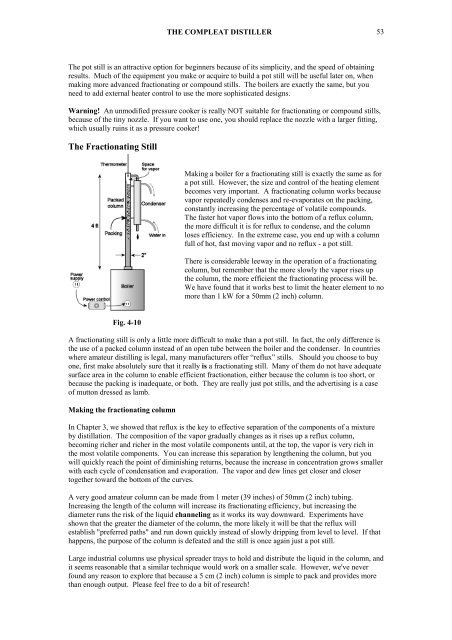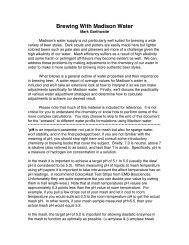The Compleat Distiller
The Compleat Distiller
The Compleat Distiller
Create successful ePaper yourself
Turn your PDF publications into a flip-book with our unique Google optimized e-Paper software.
THE COMPLEAT DISTILLER 53<br />
<strong>The</strong> pot still is an attractive option for beginners because of its simplicity, and the speed of obtaining<br />
results. Much of the equipment you make or acquire to build a pot still will be useful later on, when<br />
making more advanced fractionating or compound stills. <strong>The</strong> boilers are exactly the same, but you<br />
need to add external heater control to use the more sophisticated designs.<br />
Warning! An unmodified pressure cooker is really NOT suitable for fractionating or compound stills,<br />
because of the tiny nozzle. If you want to use one, you should replace the nozzle with a larger fitting,<br />
which usually ruins it as a pressure cooker!<br />
<strong>The</strong> Fractionating Still<br />
Making a boiler for a fractionating still is exactly the same as for<br />
a pot still. However, the size and control of the heating element<br />
becomes very important. A fractionating column works because<br />
vapor repeatedly condenses and re-evaporates on the packing,<br />
constantly increasing the percentage of volatile compounds.<br />
<strong>The</strong> faster hot vapor flows into the bottom of a reflux column,<br />
the more difficult it is for reflux to condense, and the column<br />
loses efficiency. In the extreme case, you end up with a column<br />
full of hot, fast moving vapor and no reflux - a pot still.<br />
<strong>The</strong>re is considerable leeway in the operation of a fractionating<br />
column, but remember that the more slowly the vapor rises up<br />
the column, the more efficient the fractionating process will be.<br />
We have found that it works best to limit the heater element to no<br />
more than 1 kW for a 50mm (2 inch) column.<br />
Fig. 4-10<br />
A fractionating still is only a little more difficult to make than a pot still. In fact, the only difference is<br />
the use of a packed column instead of an open tube between the boiler and the condenser. In countries<br />
where amateur distilling is legal, many manufacturers offer “reflux” stills. Should you choose to buy<br />
one, first make absolutely sure that it really is a fractionating still. Many of them do not have adequate<br />
surface area in the column to enable efficient fractionation, either because the column is too short, or<br />
because the packing is inadequate, or both. <strong>The</strong>y are really just pot stills, and the advertising is a case<br />
of mutton dressed as lamb.<br />
Making the fractionating column<br />
In Chapter 3, we showed that reflux is the key to effective separation of the components of a mixture<br />
by distillation. <strong>The</strong> composition of the vapor gradually changes as it rises up a reflux column,<br />
becoming richer and richer in the most volatile components until, at the top, the vapor is very rich in<br />
the most volatile components. You can increase this separation by lengthening the column, but you<br />
will quickly reach the point of diminishing returns, because the increase in concentration grows smaller<br />
with each cycle of condensation and evaporation. <strong>The</strong> vapor and dew lines get closer and closer<br />
together toward the bottom of the curves.<br />
A very good amateur column can be made from 1 meter (39 inches) of 50mm (2 inch) tubing.<br />
Increasing the length of the column will increase its fractionating efficiency, but increasing the<br />
diameter runs the risk of the liquid channeling as it works its way downward. Experiments have<br />
shown that the greater the diameter of the column, the more likely it will be that the reflux will<br />
establish "preferred paths" and run down quickly instead of slowly dripping from level to level. If that<br />
happens, the purpose of the column is defeated and the still is once again just a pot still.<br />
Large industrial columns use physical spreader trays to hold and distribute the liquid in the column, and<br />
it seems reasonable that a similar technique would work on a smaller scale. However, we've never<br />
found any reason to explore that because a 5 cm (2 inch) column is simple to pack and provides more<br />
than enough output. Please feel free to do a bit of research!









